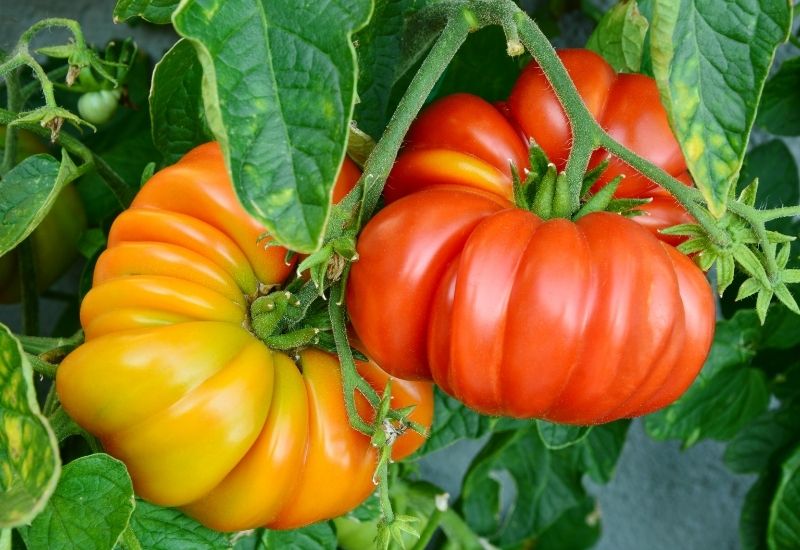
Brandywine tomatoes have been one of the most famous and beloved tomato cultivars for the last century. Their size, flavor, and juiciness are all part of what makes them so popular, especially now that they have been bred into a whole family of different colors.
If you are eager to try growing these delicious heirloom tomato varieties, or just want to learn more about them, this article is for you!
The Brandywine Tomato Cultivar
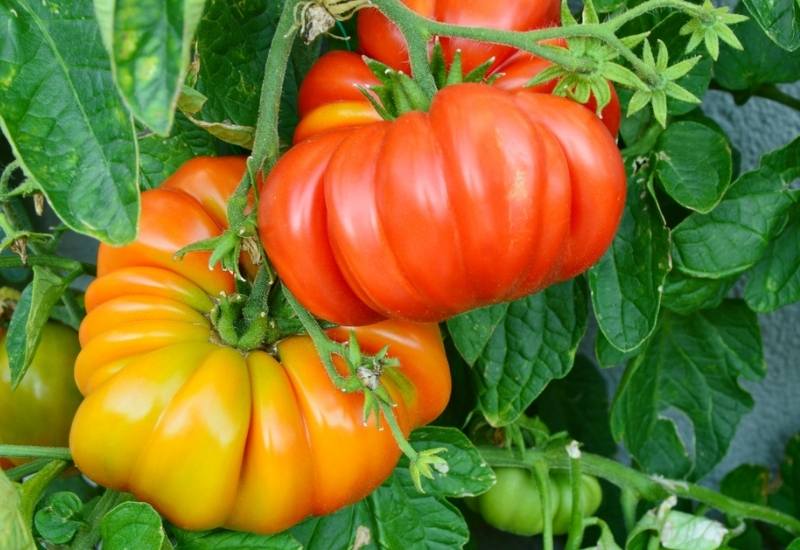
Brandywine tomatoes are an heirloom variety that has been cultivated for over 100 years, originating in the USA.
It is known for taking a long time to reach maturity and being lower yielding than other well-known varieties, but for also having an amazingly rich flavor and texture- which is likely why it has remained popular over the years.
Each fruit can weigh up to a pound and a half, and when cut open they have meaty, juicy flesh- making them great for just about every culinary use.
Brandywine tomatoes are indeterminate, meaning they will continue to grow and set fruits all season long until the first frost sets it.
The vines typically reach about 9-10 feet tall, but be aware that the fruits will take a long time to ripen- mostly due to their large size- so they should be planted in regions that have a long enough growing season to make sure they reach maturity which takes around 80-90 days.
Physical Characteristics of Brandywine Tomatoes
The ‘classic’ Brandywine tomato is a pinky-red colour that may maintain tinges of green around the stem even when it is fully ripe. It has the wide, bulging shape of beefsteak tomatoes with a slightly pointed tip at the blossom end of the fruit.
There are also other cultivars of Brandywine tomatoes that have been bred to be fully pink, orange, or yellow, and they share the same characteristics and general flavour profile of the original pinky-red Brandywine.
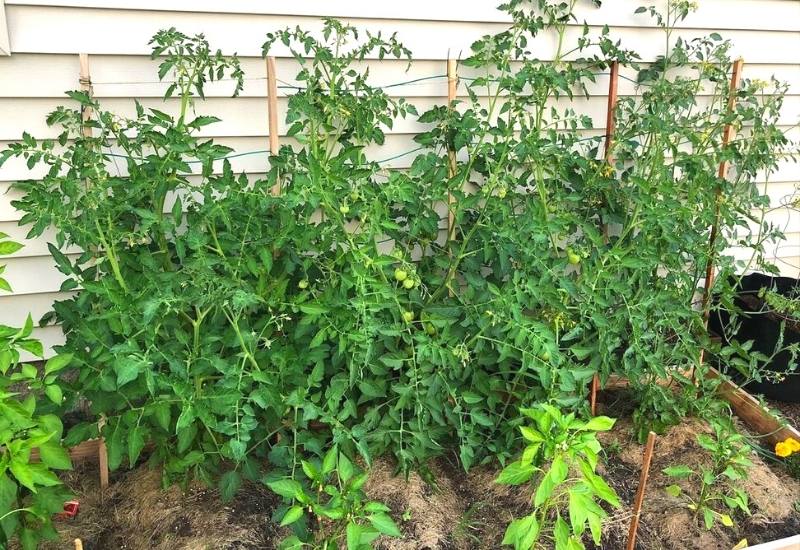
One of the most notable features of this tomato is its leaves, which differ significantly from the leaves of other common tomato varieties.
The leaves look more like potato leaves than traditional tomato leaves, with smooth edges that don’t have the characteristic jagged points that tomato leaves usually have.
The plant becomes very tall with large vines designed to carry the heavy fruits. The weight and height of this tomato plant make it hard to grow in containers, unless you have a gigantic one, and it needs a robust and sturdy trellis to support it.
Brandywine Quick Facts Table
Brandywine Tomato | Brandywine Tomato |
Tomato type: | Slicing tomato |
USDA growing zones: | 3 - 11 |
Fruit yielding: | Indeterminate |
Fruit colour: | Red, yellow, orange, and pink cultivars available |
Fruit shape: | Beefsteak |
Fruit flavour: | Meaty, low-acidity, juicy |
Fruit weight: | 1 - 1.5 lbs |
Leaf Shape: | Potato (smooth, non-jagged edges) |
Plant height: | 8-10 feet |
Days to maturity: | 80- 90, depending on the variety |
Sun Req: | 8-10 hours per day |
Soil pH Req: | 6.3 - 7.0 |
How to Grow Brandywine Tomatoes From Seed
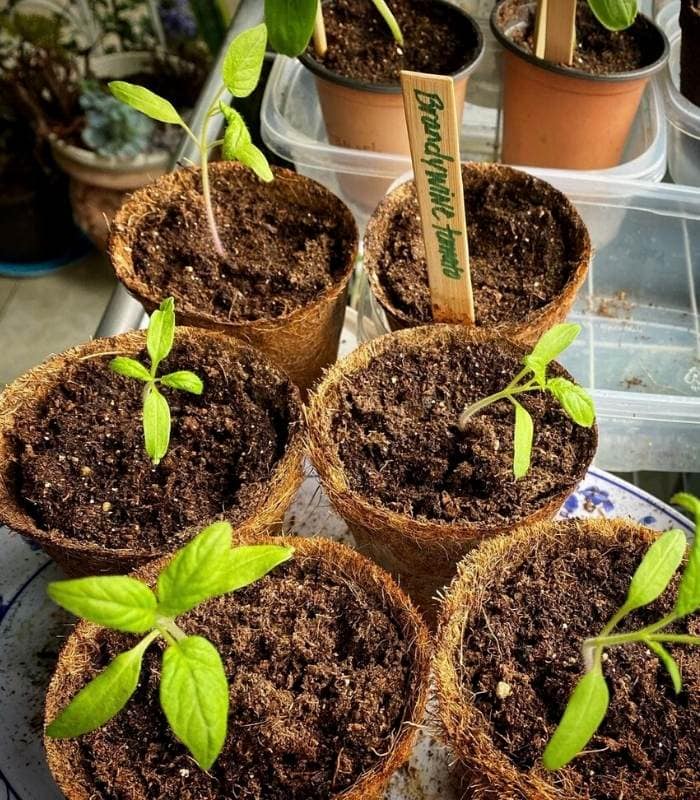
Brandywine tomatoes are hugely popular and may sell out at plant nurseries very quickly. The best way to guarantee that you can get your hands on this tasty tomato is to purchase seeds, usually online, and start them yourself indoors. Here’s how:
How to Care for Brandywine Tomato Plants
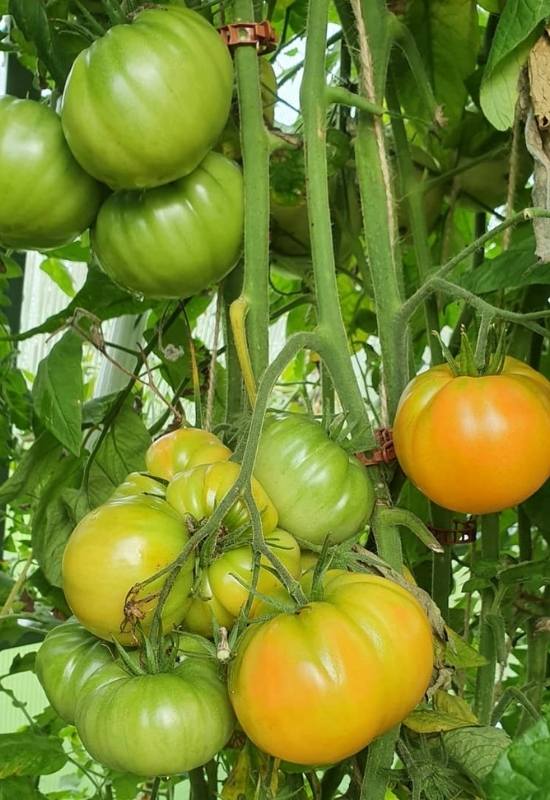
Brandywine tomatoes need the same general care requirements that all tomatoes need, but since they are a late-season tomato that becomes very large there are some specific ways that they should be taken care of- especially in the spring and early summer- to set them up for success and increase chances of a large crop.
1: Water at the soil level
Water Brandywine tomato plant once or twice a week, depending on the weather of your region, and give them a good, long soak at each watering so that the soil is totally saturated.
Brandywine tomatoes are, unfortunately, not particularly resistant to any diseases and the long amount of time the fruits spend on the vine while they grow and ripen mean they can be susceptible to fungal diseases such as Anthracnose or Early Blight damaging fruits.
The best way to mitigate the spread of fungal diseases is by watering consistently at the soil level and trying to avoid any water splashing or sitting on the leaves of the plant.
2: Plant in slightly acidic, well-draining soil
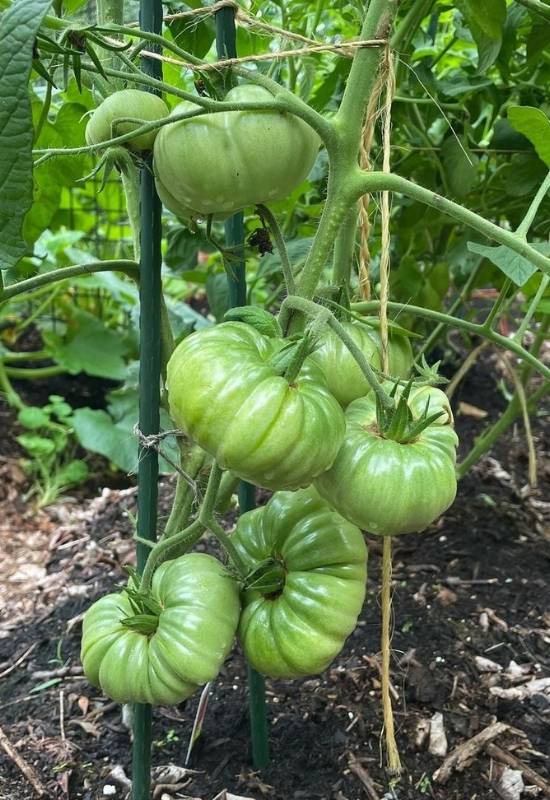
Brandywine tomatoes should be planted in soil with a slightly acidic pH of about 6.5 for optimal growth. Like all tomatoes, they need soil with excellent drainage to ensure the roots don’t wind up sitting in soggy soil, which can lead to root rot.
Brandywine varieties will do well in loamy, silty or partially sandy soils but will struggle in heavy clays, and there should be sufficient nutrients for the plants to uptake- see more below about ‘nitrogen starving’.
3: Make sure they get full sun
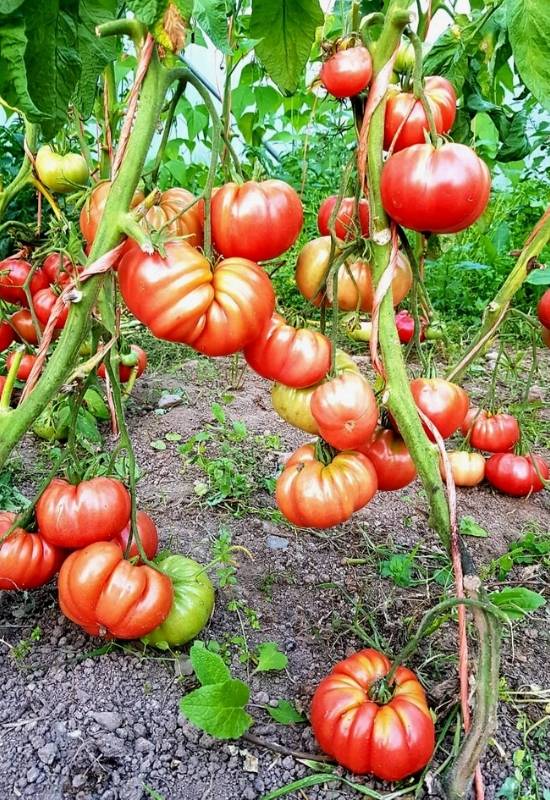
Brandywine tomatoes need full sun, at least 8 hours a day but ideally 10, and sufficient heat for the plants to set themselves up for success.
There are no shade tolerant varieties of Brandywine tomatoes, so save your best, most south-facing spot in your garden for this plant if you want it to do well.
4: Mulch around plants
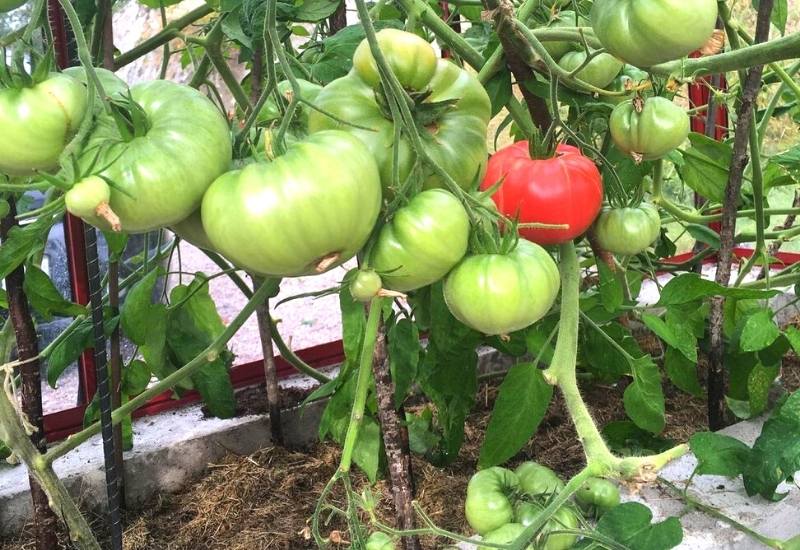
Mulching is hugely beneficial in maintaining plant health and is particularly important with this tomato variety as an extra barrier against disease pathogens that may live in the soil.
A one-inch layer of straw mulch does wonders in reducing fungal and bacterial disease rates, but make sure it doesn’t touch the actual stem of the plant as contact with constantly wet matter will cause rotted patches.
Mulching will also conserve moisture in the soil, cool the soil surface.
5: Prevent Disease and Pests
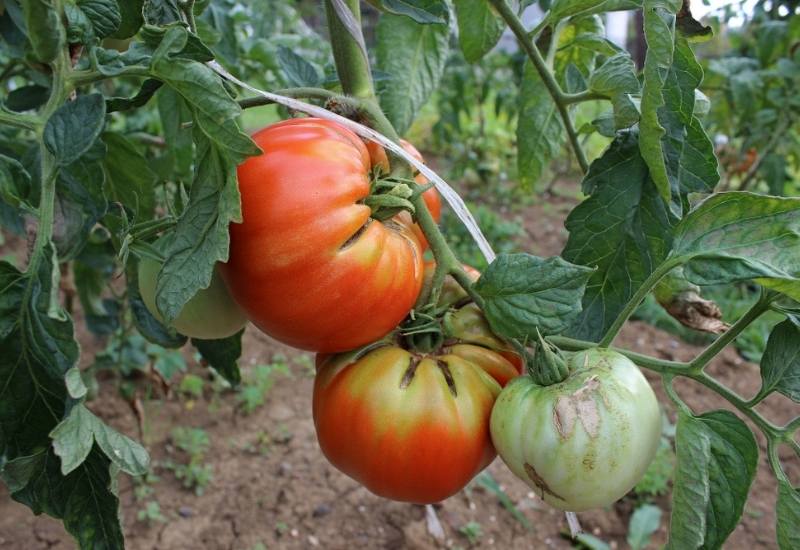
As previously mentioned, Brandywines don’t have any notable resistance to diseases or tolerance for pests, although this may vary depending on the specific variety.
It is particularly susceptible to fungal diseases like Early Blight, so follow the above watering and mulching guidelines and ensure the pathogens do not survive season-to-season by practicing crop rotation and removing plant debris at the end of the season.
6: Use a sturdy trellis
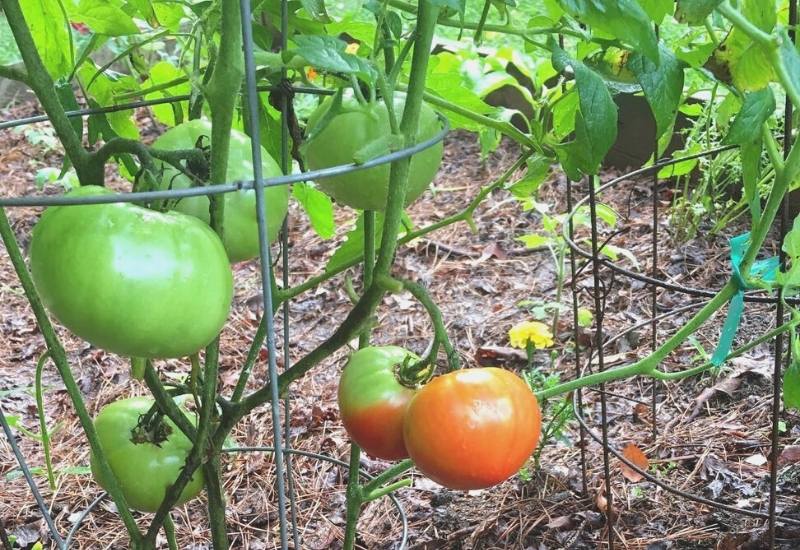
Brandywine tomato vines can become very tall, especially in warm Southern climates, so a robust trellis should be installed at the time of planting to make sure the vines have enough support throughout the growing season.
They can reach 8-9 feet, so a wire, string, or tall A-frame trellising system will likely be needed, and tomato cages won’t be large enough for the job- unless they are stacked two tall.
Make sure the trellis is set up before planting so that the roots do not become damaged later in the season.4
7: Practice ‘nitrogen starving’
Nitrogen starving is the practice of reducing nitrogen in the soil to limit foliage growth and encourage fruit growth.
Brandywine tomatoes have huge, heavy fruits that need a lot of energy to produce, and plants can sometimes end up with a lower yield when too much energy is directed at foliage growth instead of fruit production.
This is how you do it: At the beginning of the season, right after transplanting, the soil should be amended to be evenly nutrient-rich for the first few weeks of growth.
Once the plant is well established, apply a fertilizer that is rich in phosphorus and potassium but lacks nitrogen (0-10-10), so that the plant focuses its energy and resources on setting fruits. Once a good number of fruits are growing, you can use a balanced fertilizer again.
8: Remove suckers periodically
In addition to nitrogen management, you should prune the suckers off your Brandywine plants for the same reason- to encourage flower and fruit growth.
Since these plants are known to only produce moderate yields, you need all the help you can get to try and guarantee a decent crop, and the giant tomatoes need lots of space to grow without lots of bushy foliage as well.
Do still leave one or two suckers to grow at a time, as the plant of course does need some fresh branch and leaf growth for photosynthesis, and new branches will produce more tomatoes as well, just make sure suckers aren’t taking over.
Harvesting Brandywine Tomatoes
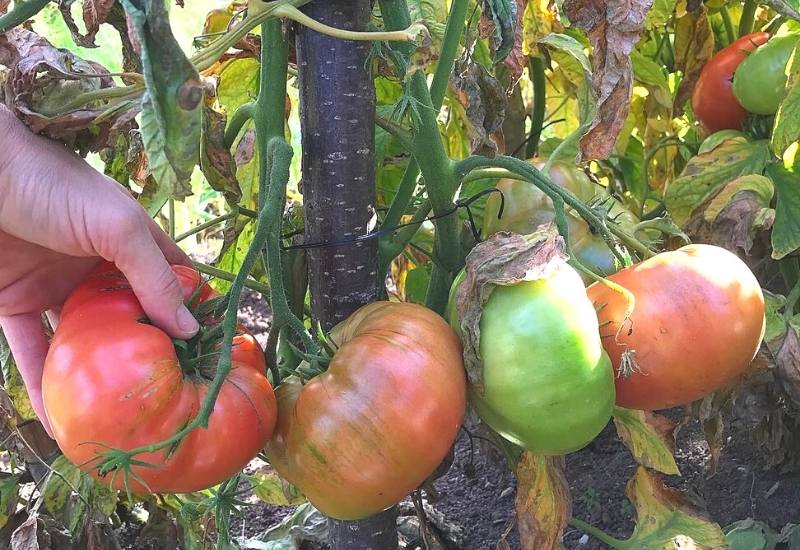
The time has finally come to harvest these giants! This is the moment every Brandywine-grower waits for with anticipation, as these long-season tomatoes take a long time to ripen and develop their signature flavour. Make sure to follow these tips for a successful harvest:
Pick the fruits as soon as they are ripe
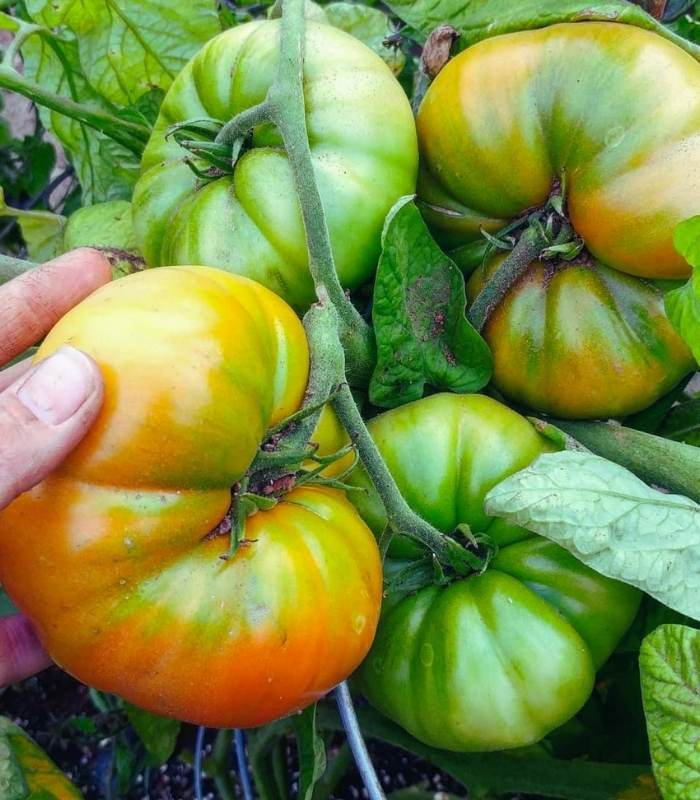
Since Brandywines take so long to ripen, it’s important to pick them at the exact moment of ripeness, or as close to it as you can, to avoid the risk of pest-eaten or damaged fruits.
When they are ripe the heavy fruits are more likely to drop from the vine, which can result in bruised or completely splattered tomatoes.
Ripe fruits left on the vine also keeps a window of opportunity open for animal pests like deer that will happily eat all the ripe fruits in one sitting.
Cut tomatoes off the vine
It is a good idea to use a sharp knife to slice large Brandywine tomatoes right off the vine, as opposed to twisting them off, as they are super heavy!
Use two hands and make sure you have a sturdy crate or box for placing fruits into, as you wouldn’t want all your long-awaited tomatoes tumbling to the ground and becoming bruised!
Keep an eye on the weather
Brandywine tomatoes are not split or crack-resistant, and if a heavy rain event is forecasted for your area you should remove all the fruits on the vine that are of size, even if they are still green, and let them finish ripening indoors.
Leaving them on the vine may result in the fruits splitting open, which makes it difficult for them to finish ripening before the open cracks become mouldy or invaded by pests.
Top plants before the first frost
Brandywine tomatoes are a long-season variety that may take 90 days to reach maturity. Depending on your growing zone, this might not leave you with too much time at the end of summer to maximize your harvest before the first frost.
About 3-4 weeks before the first predicted frost for your area, cut the growing tips off the top of your plants to redirect all the energy into ripening the giant fruits, so that you can make the most of your plant before it perishes in the cold.

Written By
Maya
Maya is a freelance content writer and avid gardener currently based in Sweden. She gained her BA in Environment and Geography in Canada, which is also where she first learnt about the detriments of the industrialized agricultural system. During the summer she began farming through the WWOOF program, and over the next six years has continued to grow and learn at a number of organic farms and gardens across the US and Canada. She is passionate about the role of regenerative agriculture in wildlife conservation and climate change mitigation, and thinks growing your own food is a key part of revolutionizing the system. In her free time she likes to read, garden, and pet nice dogs.

I want to grow brandy wine tomatoes. We are 100 days until first frost. Your article says start inside (if it is cold outside) for 4 weeks and 80 days to maturity. Does 80 days mean from when the seed is planted or when the plants are transplanted from being inside? Is it worth trying to plant these outside this late in the season? Zone 5b central ILL.
Growing Brandywine tomatoes can be a delicious endeavor! Let’s break down the timing and considerations for your situation.
The 80 days to maturity typically refers to the time from transplanting the seedlings into the garden until the tomatoes are ready for harvest. However, it’s important to note that this is an average time, and actual maturity can vary based on growing conditions.
Given that you’re 100 days away from the first frost and Brandywine tomatoes have an average maturity time of around 80 days, it might be a bit challenging to grow them from seed and harvest a full crop before the frost arrives. However, you still have a few options:
Start seeds indoors: Since Brandywine tomatoes benefit from an early start, you can start the seeds indoors as recommended in the article, allowing them to germinate and develop into seedlings. This will give them a head start before transplanting them outside.
Transplant established seedlings: If you can find established Brandywine tomato seedlings from a nursery or garden center, you can consider transplanting them directly into your garden. This will save you some time and give the plants a better chance of maturing before the first frost.
Consider season extension techniques: If you’re eager to give it a shot, you can try extending the growing season using techniques like using row covers, cold frames, or even small hoop houses. These methods can help protect the plants from early frost and provide a slightly longer growing period.
Given that you’re in Zone 5b in central Illinois, you have a relatively short growing season. Planting Brandywine tomatoes outside this late in the season might be challenging, but it’s worth a try if you’re up for the experiment. Just be aware that you may not get a full harvest before the frost hits.